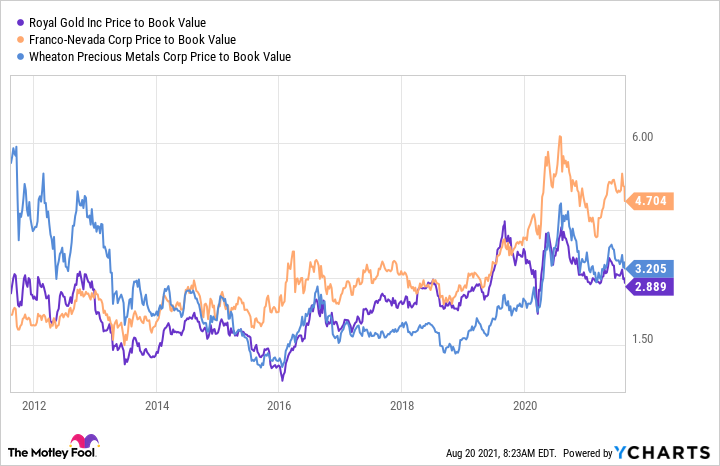Gold has long been viewed as a safe haven investment, and with the S&P 500 index trading near all-time highs it's understandable if you want to add some to your portfolio. But how do you go about doing that? Gold bullion, gold miners, gold-linked ETFs? Actually, one of the best ways to get precious metals exposure is with streaming and royalty companies like Royal Gold (RGLD -2.55%), Franco-Nevada (FNV -0.76%), and Wheaton Precious Metals (WPM -0.69%). Here's a look at each.
1. Big on gold
Royal Gold generated roughly 75% of its revenue from gold in fiscal 2021, which ended in June. The rest came from silver, copper, and other metals. That gives it the highest exposure to gold of this trio. But the interesting thing about this company, and the other two names here, is that Royal Gold doesn't mine for gold. It gives cash up front to miners in exchange for the right to buy the commodity in the future at reduced rates, which is called streaming.
Miners like this arrangement because they can raise capital (often for building or expanding mines) without tapping the capital markets or going to a bank. Royal Gold likes it because it locks in low metals prices. As an example, a recent streaming deal pegged the company's costs at 20% of gold's spot price until certain production targets are hit, and then 40% thereafter.

Image source: Getty Images.
This, in turn, generally means wide margins for gold in both good times (like right now) and bad. Miners tend to see margins nosedive when commodity prices fall because of the relatively fixed nature of their mining costs. Precious metals themselves, meanwhile, go up and down with supply and demand dynamics and don't offer growth outside of these price movements. Miners and streamers can invest in new assets. The underlying consistency of Royal Gold's business model is how it has managed to increase its dividend for 20 consecutive years despite the inherent volatility of commodity markets.
Fiscal 2021 was a very good year for Royal Gold, with record revenue, record net income, and record cash flow. But the future's looking bright, too. The company has no debt, so it has plenty of ammunition for future investments. It has one mine investment that has just started producing, has recently acquired two new mine investments, and has a number of legacy investments that are progressing well. In other words, Royal Gold's business is in growth mode right now and investors can get in on that opportunity by adding it to their portfolios today. To be fair, the stock isn't exactly cheap, given the recently strong precious metals markets, but it has the lowest price-to-book value ratio of this trio. Add in the investments that are starting to bare fruit, and it's a compelling option for people looking for a gold investment today.
2. The diversified option
Franco-Nevada is also a good choice, but it does things a little differently. Gold accounted for around 56% of its revenue in the second quarter, with silver and platinum coming in at 13% and 6%, respectively. Other metals were 11% and oil and natural gas investments were 14%. That's vastly different from Royal Gold and Wheaton. However, for conservative investors who want to hedge their commodity-linked bets a little bit, this diversification could be an attractive attribute.
Franco-Nevada's diversification doesn't stop there. It has 407 investments in its portfolio, 58 producing mines, 55 producing energy projects, 47 advanced mine projects, with the remainder made up of development metals mines and energy projects. Its portfolio is way more diverse than either of its peers. And the company has increased its dividend for 14 consecutive years. Not a bad combination of attributes.
Meanwhile, Franco-Nevada expects to see record results in 2021, backed by strong first-half results (including record second-quarter revenue and net income) and new investments. If you want exposure to gold, but also want to hedge your bets a little, Franco-Nevada would be a good choice. That said, it is the most expensive of this trio based on price-to-book value, but it might be worth the price for conservative types.
RGLD Price to Book Value data by YCharts
3. Sharing the wealth
Wheaton Precious Metals is the last name up. In the second quarter, 49% of its revenues came from gold, with silver at 45%. The rest of its revenues came from platinum group metals and cobalt. Stepping back, it is probably the best of this group for investors interested in precious metals as opposed to a pure gold investment. Like the two names above, it has been posting record results of late.
But the most interesting thing here is probably Wheaton's dividend. Royal Gold and Franco-Nevada focus on slow and steady dividend growth, while Wheaton's dividend is variable, pegged at 30% of the average cash generated over the trailing four quarters. That's not desirable if you prize consistency, but it means investors get to benefit directly during the good times. If investors flock to precious metals in a market dislocation, that could mean higher dividends right when other parts of your portfolio might be struggling. The gold/silver balance and unique dividend approach together could make this the best option for investors looking to precious metals as a safety play.
Time for a deep dive
This trio of large streaming and royalty names all do the same basic thing, but they each go about it in notably different ways. Royal Gold will provide the most exposure to the so-called barbarous metal, Franco-Nevada is by far the most diversified name, and Wheaton's gold/silver balance and variable dividend policy is an interesting option for investors focused on the safe haven nature of these metals. If you are looking at gold today, one of these three names is likely to tickle your fancy.





